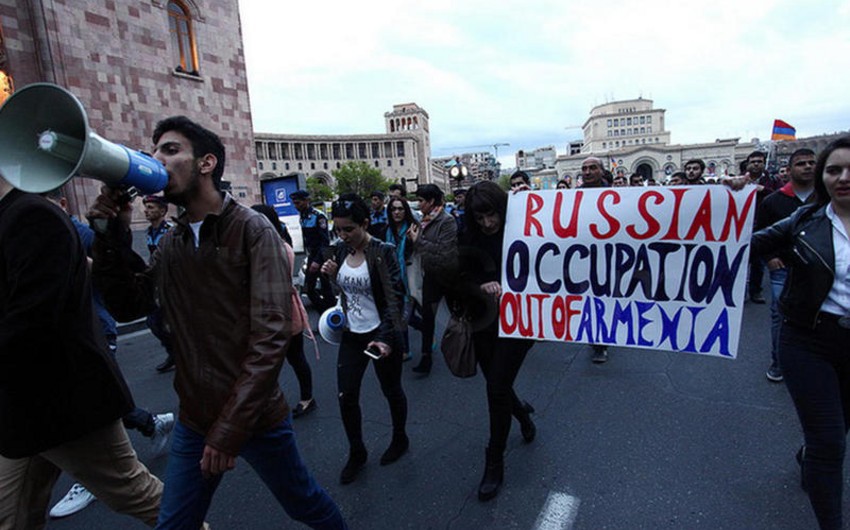Baku. 23 November. REPORT.AZ/ Today, Armenia is the only country in the South Caucasus where Russian military base is located. Therefore, Yerevan considers itself as the main strategic ally of Moscow in the region. However, in the past decade, anti-Russia sentiments went on rise in Armenia. This was manifested in various protests in the country. The then president of the country, Robert Kocharyan, used force on March 1, 2008 against protesters in downtown Yerevan, demonstrating against disputed results of the presidential election. As a result, more than 10 peaceful protesters were killed, many were injured and wounded. Despite protests, Serzh Sargsyan was declared the country's president. After these protests, the Armenian public stood against Moscow. The slogans such as "Invader Russia, leave Armenia!" were put forward. Since 2013, there has been a marked tension between the two countries. An action was held in Armenia in the summer of 2015 to protest raising electricity prices in Armenia. It was not just a protest action against price increases but also a protest against Russia's control over energy sector in Armenia. They demanded the authorities to put an end to the arbitrariness of the "Electric Networks of Armenia" CJSC, which declared that Russia would lift electricity tariffs again. After these actions, the situation did not normalize.
In fact, the international community is well aware of the fact that the Armenian state is a Russian project with the Kremlin controlling most of the country's economy, including energy and railways. The issue of russophobia did not resolve during the attack by the armed group of "Sasna Tsrer" on police in 2016. This group took security officers hostage during an attack on one of the police stations. The residents held a protest action every night to demonstrate solidarity with the armed group. Most of the protesters at that time condemned Russia for interfering in Armenia's domestic affairs

Armenian analysts believe that Sasna's struggle is the first stage of the fight against Russian colonialism. The resistance of the group members did not last long. They were arrested. At that time, Nikol Pashinyan, who was the deputy, visited members of "Sasna" in prison and defended their rights. After the coup in May 2018, the government of Nikol Pashinyan included them in the pardon list. Thus, it was a green light for those considering Russia as a colonialist in Armenia. It was also a clear indication that the new political force that came to power demonstrated anti-Russian sentiments. If we develop the idea of Armenian analysts, it turns out that Pashinian's "revolution" is the second stage of the struggle against "colonialism." Armenians call "Sasna Tsrer" group as the"savior" of Armenia. Then, Nikol Pashinyan and his movement are part of this stage.
Sasna’s new program was adopted at the summit held in September this year. One of the main tasks set before the organization by the program was ‘to release Armenia from Russian colonialism'. In line with this document, Russian border troops must withdraw from the Armenian territory and the territories guarded by them must be handed over to the Armenian border troops. The program announced that unification of Armenian and Russian air defense systems is illegal. The organization also proposed to close the Russian military base No 102 in Armenia. Sasna considers it necessary to establish strategic partnership with the United States and Iran and to bring the relations with the European Union, Georgia, Ukraine, China and India to a new level. They believe that there is no need for a state border with Georgia. According to Sasna supporters, by this way they would settle the issue with Georgia’s Javakheti.
In general, this radical nationalist organization is also an embodiment of anti-Russian sentiments in Armenia. This role was once played by Dashnaks. But that left-wing Armenian Revolutionary Federation (Dashnaktsusyun Party) never spoke against Moscow. On the contrary, they made use of Kremlin’s capabilities in their activity. Over the past years these ‘revolutionists’ assisted the government in the political processes ongoing in Armenia. During the May events they quickly abandoned their stance and started defending Nikol Pashinyan’s movement in a hope to get seats in the new government. But the subsequent events showed that Pashinyan supporters deceived them. It seems that after making use of Dashnaks, the role of radical nationalists on the new political stage established by Armenians was entrusted to Sasna tsrer. Armenia which depends on Russia needs to have a stronger sponsor to stand against Moscow. Otherwise, pulling out Dashnanks from the market would not have been such an easy thing.


